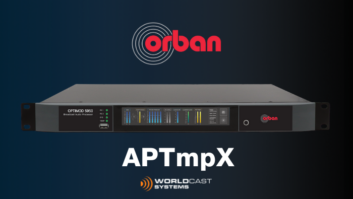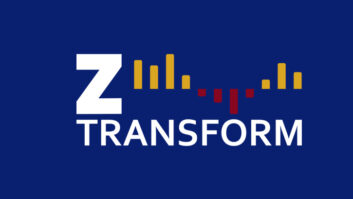
Few topics these days get radio engineers and programmers talking heatedly like the 25-Seven Systems Voltair box and the related bigger debate over Nielsen’s PPM audience measurement methodology.
One interested observer is Bob Orban, founder and chief engineer of the processor manufacturer that bears his name, which is a competitor to Voltair’s parent the Telos Alliance. Many stations that are measured by PPM — and many that, presumably, use Voltair — also employ Orban processors. We checked in with Bob Orban to see what the company is telling users.
Radio World: You told your customers recently, “While it is true Orban’s Optimod processors are compatible with Voltair, we urge caution.” Can you expand on that?
Bob Orban: We urge caution because according to Nielsen, Voltair degrades audio quality when used at higher settings, and because stations buying Voltair run the risk of ending up with an expensive white elephant after Nielsen issues its fall update for the encoders. If the Media Rating Council concludes that Voltair is artificially skewing ratings and that some measured “listeners” are more valuable to advertisers than others, this is a further source of uncertainty.
As for compatibility with Optimod, we just wanted to assure our customers who choose to use Voltair that they can continue to interface their Optimods to their ratings encoders as they always have in the past, and they can include Voltair in that signal path. Ratings encoders are usually placed either directly before the Optimod’s input, or in the Optimod’s “ratings encoder loop-through” path.
RW: It seems likely that at least some Optimod users are using the Voltair. Do you have a sense of how many, and what their experiences have been?
Orban: To be honest, I don’t. Stations using Voltair tend to be quite secretive about it.
RW: What’s the most common question you’re getting about Voltair from engineers and programmers?
Orban: “How do I use it with Optimod?”
RW: Clearly, this product has hit a nerve in the radio industry. What do you think the experience of the past months says about radio’s underlying measurement platforms?
Orban: I have heard a number of anecdotes, but nothing I consider to be definitive. Since we created the press release about Voltair I became aware of a very interesting series of blog posts from Randy Kabrich. Randy analyzed a number of ratings books to try to detect whether Voltair significantly changed Nielsen’s final numbers in the book (as opposed to the number of successful watermarked detections within a given quarter hour), and he concluded Voltair appeared to have little or no effect on the book. While I am no expert analyst of ratings statistics, Randy’s blog certainly gave me food for thought. I know that these blog entries have been controversial.
Nielsen’s own testing concluded that Voltair was only likely to increase detectability in environments where the program material was marginally intelligible or unintelligible to human listeners because of noise contamination. Regardless of whether the current Nielsen encoders provide accurate measurement in environments where people can actually enjoy listening to the radio (and can respond to commercials), Voltair created a perception problem for Nielsen by increasing the number of successful detections in a given quarter hour, and I speculate that this is what Nielsen is trying to address in its fall encoder update. That is, Nielsen is trying to increase the comfort level of its customers, many of whom live and die by their ratings.
RW: If Voltair can increase the number of listeners credited by PPM measurements, shouldn’t everyone get one?
Orban: I will answer with questions: Given that Nielsen concluded that Voltair degrades audio quality, why would FM radio stations engage in a race to the bottom when they are under heavy competitive pressure from new media that can already provide a superior listening experience without the legacy FM problems of multipath distortion, picket-fencing in mobile reception, and preemphasis -induced headroom limitations at high frequencies? Isn’t this just the psychology of mutually assured destruction where the playing field is eventually leveled but all the players end up sounding worse?
RW: You said you decline to add processing to Optimods that manipulates the Nielsen watermark signal, preferring to wait for Nielsen’s promised encoder improvements. What will you be watching for, to decide if they do what they promise?
Orban: I will be paying careful attention to Nielsen’s presentations regarding its encoder improvements, particularly if Nielsen provides credible technical data and measurements to back up their claims. I will withhold my judgment until Nielsen’s new encoders have been deployed long enough to allow experts from the programming side to do statistical analyses that either back up Nielsen’s claims or disprove them. Because of the natural “noisiness” of ratings from book to book, I expect it will take some time before definitive answers emerge. I will also ask people whose ears I trust to listen to signals encoded with the new Nielsen encoder but without Voltair, and then tell me if they can hear the watermark. However, I will give particular weight to double-blind listening tests that indicate that the new encoders create an inaudible watermark that does not degrade audio quality.
RW: What else should radio engineers and managers know about this issue?
Orban: Extrapolating from Nielsen’s second quarter 2015 financials, the company appears to have gross revenues exceeding $5 billion per year and generates free cash flow in excess of $500 million per year. Nielsen’s gross revenues are more than one third as large as the total advertising revenue of all United States radio stations combined ($13.6 billion in 2014). Nielsen’s business model hinges on providing accurate ratings, and they have the financial and technical wherewithal to do whatever is necessary to defend their business model by delivering credible ratings to their customers. Voltair may have served as a useful wake-up call for the company, but I am confident that if they indeed have a problem, they will fix it.











